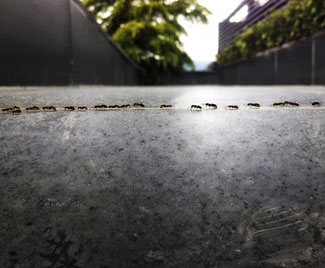Ant Invasion – What Can You Do?
By Chris Williams on December 17, 2014.
 There they are again. A trail of tiny ants moving along the baseboard, up the wall, along the counter top, into the sugar bowl… Where are they coming from?
There they are again. A trail of tiny ants moving along the baseboard, up the wall, along the counter top, into the sugar bowl… Where are they coming from?
You might first see invading ants outside around your home’s foundation, under the sidewalk, or in an old tree stump. They can find their way inside through the tiniest crack, looking for food (see What Causes Occasional Indoor Ant Problems?). Some ants will nest inside a building in walls, behind baseboards, or in potted plants. Carpenter ants are the most destructive indoor ants since they tunnel into wood.
Ants are social insects which means that they are part of a large colony containing workers and a queen (see How Do New Ant Colonies Start?). The workers tend the nest and hunt for food to feed to the queen and others in the nest. Under certain conditions, winged “swarmers” will emerge from the nest. Their purpose is to fly off, mate, and establish new colonies. Swarming ants can easily be confused with swarming termites, but a pest control professional knows how to tell the difference.
Getting Rid of Ants is Not a DIY Job
Some ants can also start a new colony by simply dividing the first one and moving to a new location. The ants that you see inside may have more than one nest site, so it’s important to use a control method that will affect all of the ants that make up the colony. It’s extremely difficult to get rid of ants on your own. Simply spraying won’t do it, and some ants are repelled by insecticides causing them to break up the colony into several smaller nests. It’s important to use a professional control method that will eliminate all of the nests.
What Happens After You Call an Exterminator?
Our pest control expert will identify the type of ant pest, inspect for ant trails and nest sites, and recommend a control method or methods suited to your particular problem:
- Strategically placed baits are one method of professional ant control that is especially useful when the nest can’t be located for treatment. Ants carry the bait product back to the nest site(s) where it is fed to other ants, including the queen.
- Barrier insecticide treatments might be used to cut off an indoor ant nest from its sources of food and water. If we locate an ant nest indoors, we can inject it with insecticide.
- Or, our specialist may suggest an exterior preventative “perimeter treatment” to keep outdoor ants from finding their way inside (see Preventative Maintenance Program Keeps Pests Away Year Round).
Whichever control methods we recommend for your ant invasion problem, you can bet that we will be around until the problem is solved. Give Colonial a call today. Let us help make your home ant-free.
Sign up for our biweekly email newsletter for more information about bugs and pests!